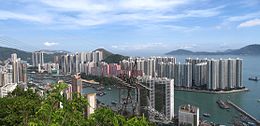Ap Lei Chau
| 鴨脷洲 | |
|---|---|

Ap Lei Chau viewed from Hong Kong Trail Stage 2, in the Hong Kong Island, across Aberdeen Harbour. (2008)
|
|
| Location of Ap Lei Chau within Hong Kong | |
| Geography | |
| Location | South of Hong Kong Island |
| Coordinates | 22°14′30″N 114°9′20″E / 22.24167°N 114.15556°ECoordinates: 22°14′30″N 114°9′20″E / 22.24167°N 114.15556°E |
| Area | 1.3 km2 (0.50 sq mi) |
| Highest elevation | 196 m (643 ft) |
| Highest point | Yuk Kwai Shan (玉桂山) |
| Administration | |
| District | Southern District |
| Demographics | |
| Population | 86,782 (2007) |
| Pop. density | 66,755 /km2 (172,895 /sq mi) |
| Ap Lei Chau | |||||||||||||
| Traditional Chinese | 鴨脷洲 | ||||||||||||
|---|---|---|---|---|---|---|---|---|---|---|---|---|---|
| Literal meaning | Duck tongue island | ||||||||||||
|
|||||||||||||
| Transcriptions | |
|---|---|
| Hakka | |
| Romanization | Ap5 li4 Ziu1 |
| Yue: Cantonese | |
| Yale Romanization | Aap leih jāu |
| Jyutping | Aap3 lei6 zau1 |
Ap Lei Chau (Chinese: 鴨脷洲), or Aberdeen Island, is an island of Hong Kong, located off Hong Kong Island, next to Aberdeen Harbour and Aberdeen Channel, with an area of 1.30 square kilometres (0.50 sq mi). Administratively, it is part of Southern District. Ap Lei Chau is the second most densely populated island in the world.
On a map dating from the Ming dynasty, the island is shown, together with a village with the name "Heung Kong Tsuen", the literal meaning of which in Chinese is "Fragrant Harbour Village" (香港村). This is probably the origin of the name "Hong Kong".
Before the First Opium War, Ap Lei Chau was essentially a fishing village. As a consequence of the Treaty of Nanking, it was in 1841 ceded to the British together with Hong Kong Island.
Since then, little attention had been paid to this small island, although Ap Lei Chau does shelter Aberdeen Harbour, creating an excellent natural typhoon shelter.
In 1968, Hongkong Electric opened a power station on Ap Lei Chau to provide electricity for the whole of Hong Kong Island. In 1980 and 1994, a bridge was constructed to connect the island to the Hong Kong Island, and this created momentum for rapid economic development. Public housing estates were built to accommodate people, including some who had suffered in a fire in the Aberdeen shelter.
...
Wikipedia

